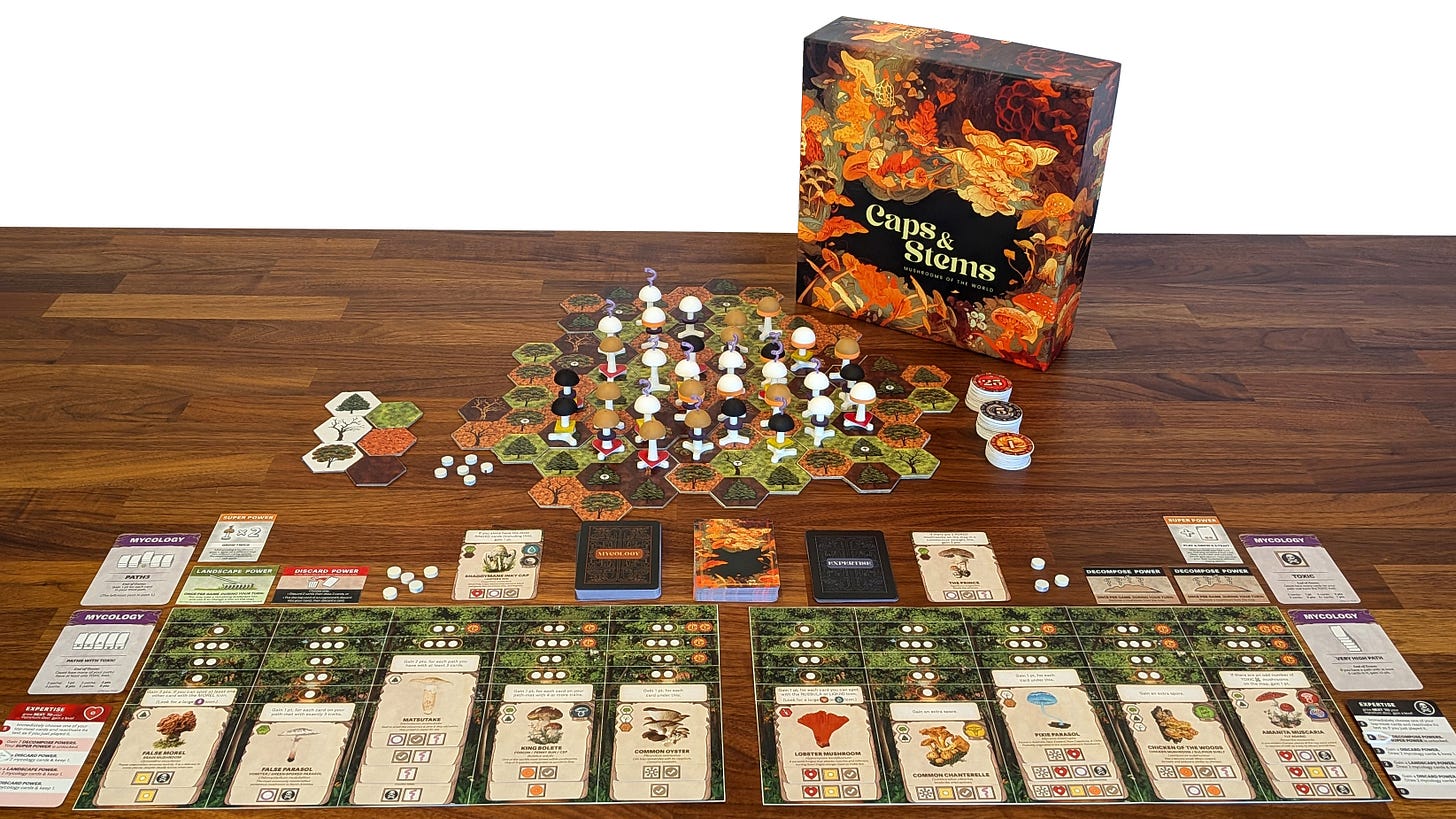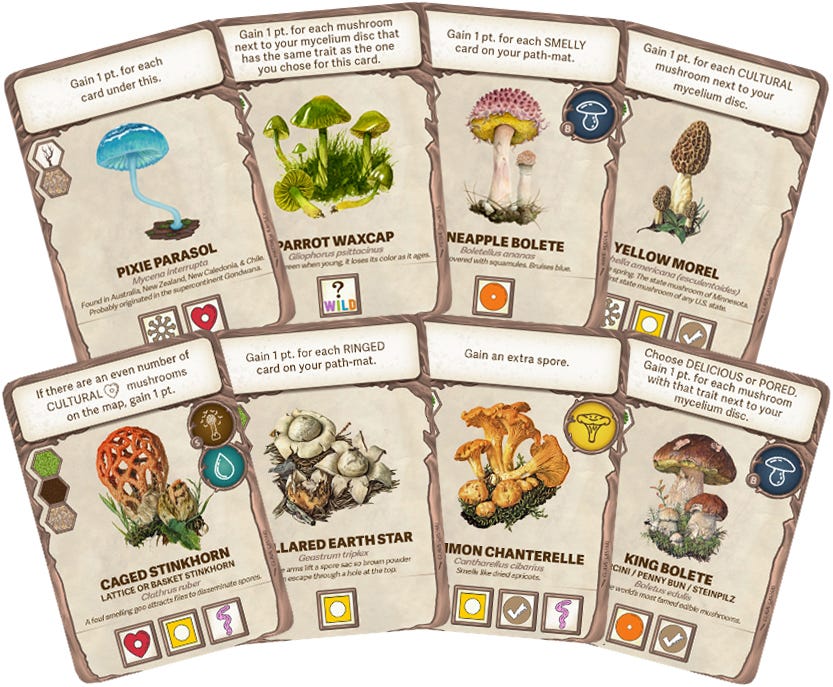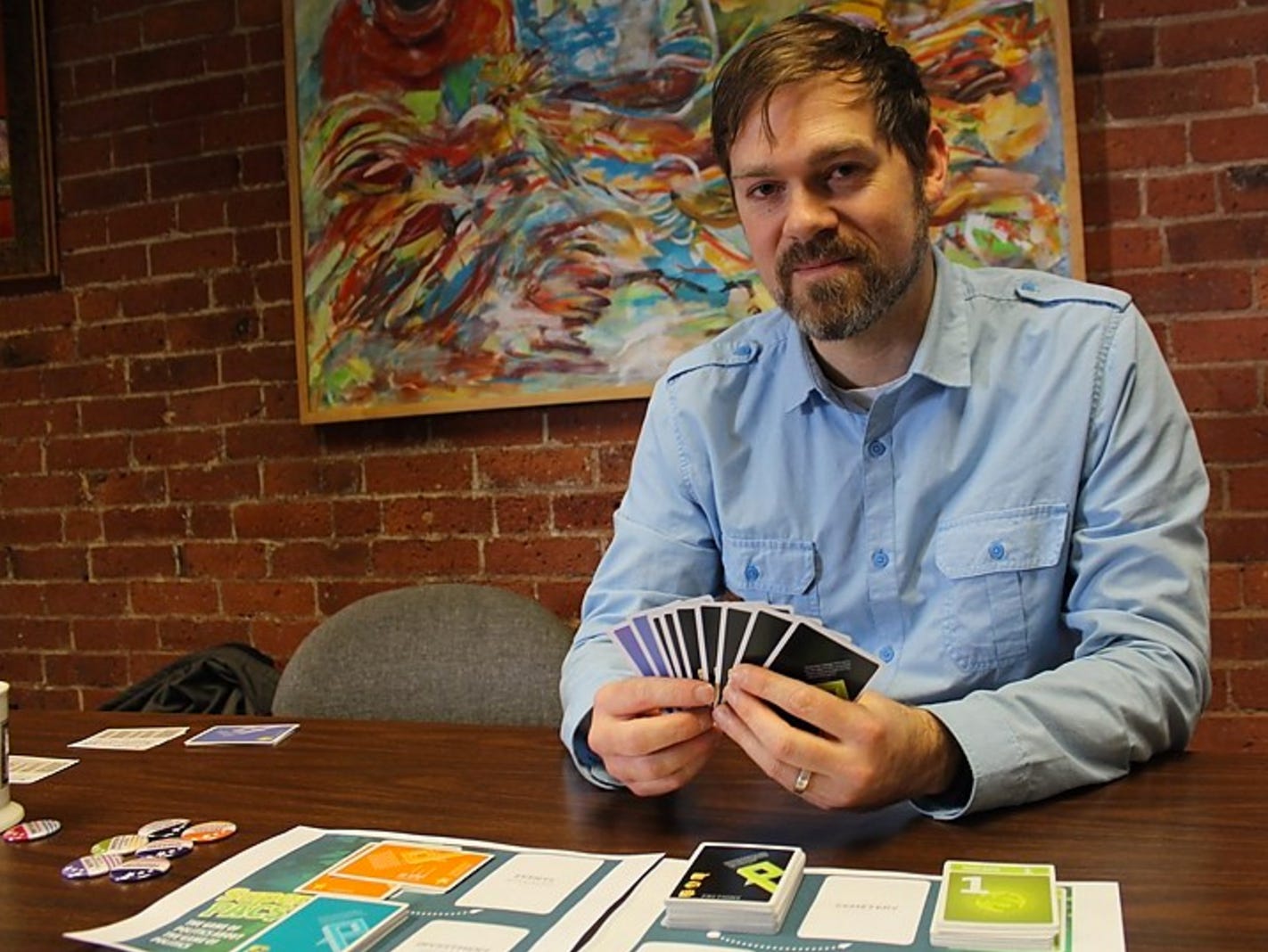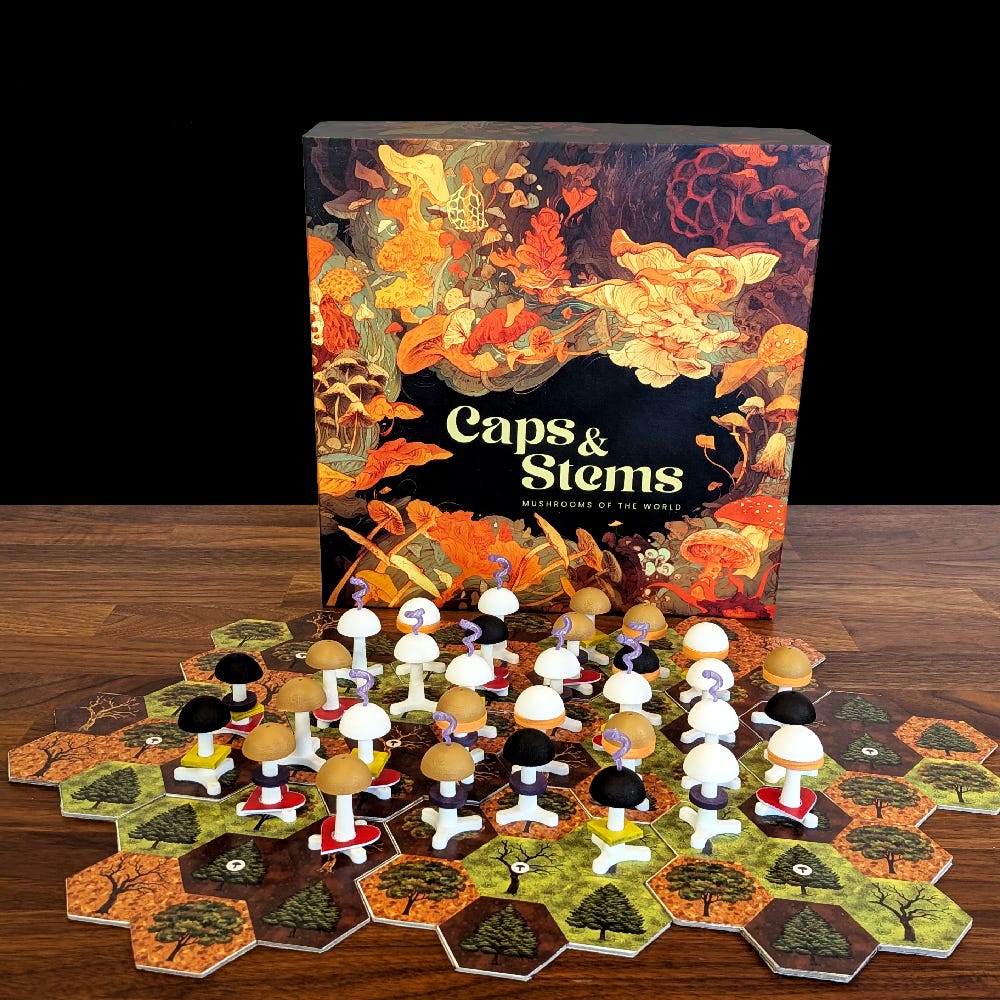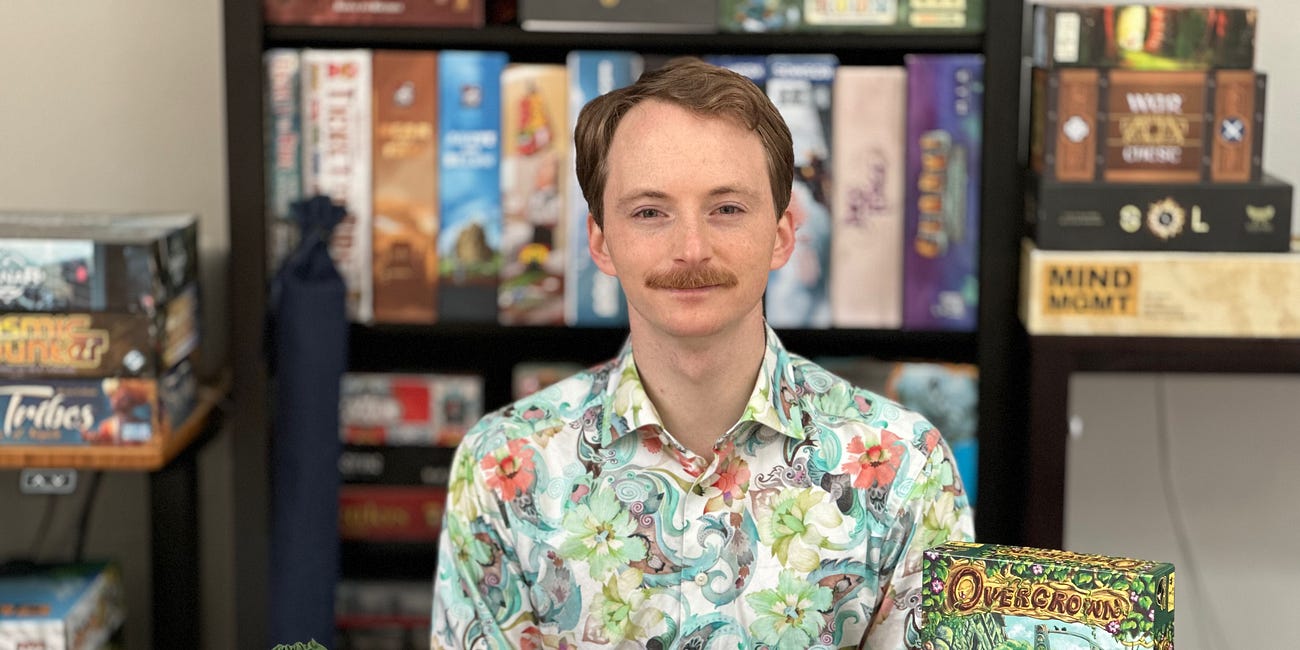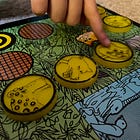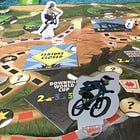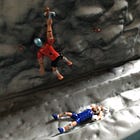Caps and Stems: ‘Let's build mushrooms'
We speak to designer Brandon Patton about his strategic fungi-foraging tabletop game
Cosy, nature-based hobbies have inspired the board game industry in recent years.
Elizabeth Hargrave’s Wingspan demonstrated that bird watching held a wide appeal as a game theme that rivalled tabletop regulars such as sci-fi, zombies, pirates and dinosaurs. It’s sold more than 2.5 million copies since its launch in 2019.
Other titles incorporating trail walking (Parks), gardening/botany (Verdant), beekeeping (Honey Buzz) and broader wildlife (Cascadia) have also demonstrated there’s a market for this trend.
Mycophelia – the enthusiasm for collecting, categorising and consuming mushrooms – has also formed the theme of several recent titles. That latest of which is Caps and Stems, a fungi-hunting strategy game that sees players assemble their own 3D mushroom pieces with individual traits to improve their score and become the most respected mycologist.
Before its launch on Kickstarter, we spoke to the game’s designer, Brandon Patton, to find out more.
The mushrooms in the game have different values depending on what components are placed on the stems. How does this play out, pointwise?
BP: There are eight traits that mushrooms can have.
Trait icons are shown on each mushroom card so you know which traits it has. Each trait icon corresponds to a physical game piece that fits on to the 3D mushroom.
The cluster and cultural pieces have a wide hole in the middle, and slide down the stem all the way to the bottom. The ring and ‘unusual’ pieces rest about halfway up the stem. The pored piece stays right underneath the cap, like in real life. (Some mushrooms have ‘pores’ instead of ‘gills’ or ‘teeth’.)
‘Toxic’ or ‘delicious’ is represented by black or brown caps. Mushrooms that are neither toxic nor delicious use white caps. ‘Smelly’ is a squiggly spiral-like piece that sticks into a small hole on the top of the cap.
The trait pieces are all coloured so they are easy to distinguish from the white stem, or a white cap. White pieces are free but do not add to your score.
When you grow a mushroom, you have to spend one spore for each trait piece you need. The more traits the mushroom has, the more valuable it is. Most mushrooms have two or three traits, but they range from one to five.
It takes time to acquire five spores, so even though those are very valuable, you usually have to pass for a turn or two before you will have accumulated five spores you can spend.
When the mushroom is placed on the map, you always get, at a minimum, a point for each trait it has. Then, you also get points for every matching trait piece on any neighbouring hex. So, for example, let's say you play an amanita muscaria, which has three traits: toxic, ringed and cultural. If it has no neighbours, you will get three points. If it has two neighbouring mushrooms, let's say both are ringed and ‘pored’. Pored is ignored since it doesn't match, but you'll get two additional points for the ringed pieces nearby. Five points total.
In reality, it is rare to have the exact same mushroom traits, in multiple, neighbouring spaces... I think 17 is the most I've ever seen scored in one play.
Another way the traits interact with gameplay is that you place cards on to your paths. You can stack mushroom cards on top of other mushroom cards and higher stacks of cards start getting you more spores. But you are only allowed to stack cards if all cards in the same path have a trait they share in common. So you have to make decisions about which cards to put where.
Then, at the end of the game, you have secret agenda cards (I call them mycology cards) that reward you for the traits on your path mat, or how many cards are on a specific path.
What was the inspiration for the game. Are you a keen forager?
BP: I played Wingspan during the first year of the pandemic and immediately thought, ‘oh cool, you could do something similar with mushrooms’.
There are lots of nature-nerd social groups out there, but in my experience the birdwatchers and the mycophiles are the two biggest cohorts. So not only was it a cool idea to make cards based on different species, which Wingspan had demonstrated success with, but I also knew there was a sizable and fanatical audience, so maybe it even had commercial potential. I quickly got to work... (five years later I'm finally launching, ha ha).
I first got interested in mushrooms after an interesting chicken-of-the-woods entree at a restaurant back in, probably, 1998. In 2000, I was on a road trip and saw that there was a mushroom festival going on in Telluride, so I visited the festival. I didn't know it then, but the people who were giving talks and showing us things in the woods at that festival are some of the celebrities of the mushroom world. Paul Stamets, Gary Lincoff, Sasha Shulgin, Andrew Weil - these were the nature nerds who were geeking out about fungi, and spreading their knowledge and enthusiasm.
I started trying to learn more, and I started doing some foraging, or at least just venturing out to look at what I could find, but a few years later I ended up in New York City and it was pretty hard to escape to nature.
The year that I played Wingspan, I had just moved to Seattle, and the Pacific Northwest is one of the most wonderful places to go mushroom hunting anywhere on earth. I was excited to finally act on this dormant enthusiasm, and I joined the Puget Sound Mycological Society, and started buying field guides and hanging out with all these mushroom fanatics.
The number of times I've actively foraged for edible mushrooms is small, more than a handful of times, but not that much. But I've spent many more times just looking for mushrooms and taking photos of them, trying to ID them from books, or sharing the photos with more knowledgeable folks at my club.
There’s a simplified version of the game’s rules to play with kids. How does this differ from the main game?
BP: I have two young daughters, and they don't care about maximising points, and they don't like losing. So the kid’s version just focuses on ‘let's build mushrooms!’
You play a card, get the pieces you need for free, decide where to put it on the map. Then, if you want to, you can score the mushroom, which goes to a communal treasure that everyone shares when the game ends.
The mushroom figurines and traits are a big draw. How did you decide how these traits were represented?
BP: It was a really long process. I started out with field guides, and just started categorising mushrooms based on the info in books and websites, with a bias toward interesting-looking mushrooms, distinctive-looking mushrooms.
I ended up with a massive spreadsheet of species that all had something cool about them, but not much in common. I was hoping for a few simple categories that would be evenly distributed, or something like that. In reality, it was really difficult to figure out what categories would include lots, but not too many, species.
I knew that I wanted to do something with the rings on the stipes – but there really are only a few genera with rings, it's nowhere close to, say 25% of all mushrooms.
The first big taxonomic divide in fungi is ascomycetes vs. basidiomycetes, which has to do with how the spores are formed at the microscopic level... but since it's microscopic, it's not very useful visually for a game piece.
Early on, I thought maybe I could do something with colour. Some mushrooms have a visual beauty that interests us aesthetically, and usually there is some colour aspect to it. In my early versions you had to purchase the colours you needed to assemble the mushrooms, but I had to really dig deep for a variety of colours. There are so few blue and green mushrooms, that if that was supposed to be a resource it would be an extremely rare one. There are lots of variations on brown and white. I ended up with brown, white, and yellow, with some red and even fewer ‘other’.
It had potential but I ended up more excited by morphological features. And I also learned that mushroom colours are somewhat variable – they aren't quite as reliable as, say, bird feathers, or berries.
I also tried doing something with sporeprints. By now, I had about 200 mushrooms that were vying for inclusion in the game, so any category that might work got applied to those species. The spore colours were lots of variations on brown, a fair amount of white (or clear), and then even fewer that were just ‘other’ – black, bluish-black, reddish, greenish, what have you. It wasn't the right distribution for my design.
I also intuited that people who don't know all that much about mushrooms would be interested in poisonous and edible as concepts – and my interactions with play testers confirmed this. So that was decided early on. The only problem here was that lots of mushrooms are edible but are not actually good. So I went with ‘choice edible’ but the gamer crowd was confused by the word ‘choice’ since that implied a decision needs to be made, so I settled on delicious.
Which mushrooms are delicious? There is general agreement on the famous ones sold in stores, but there are lots of other slightly less known species and it comes down to personal taste. One person's delicious is another person's disgusting. In the end, I relied on a mycologist to help me gauge some sort of loose consensus, while being forced to acknowledge cultural bias... but I had to decide somehow which mushrooms get the delicious tag.
The poisonous category you'd think would be easier but actually there is a lot of wiggle room there, too... some people die eating mushrooms that others find delicious. Some of the mushrooms that Westerners avoid are considered delicacies in other places, and possibly they know how to detoxify them by cooking them a certain way. Again, I had to go with a sort of Western field guide consensus. And there really aren't all that many deadly mushroom species, so ‘toxic’ included mushrooms that had a reputation for giving people a stomach ache. And still, I needed a few more toxic species for the probabilities I wanted, so I decided to include all the psychoactive mushrooms in this category, which is really not fair if you're a fan of psychoactive mushrooms, but I figured it was justifiable to have a toxic category that essentially meant ‘mushrooms with chemicals in them that will affect you in some intense way, so be warned’.
In the end it just came down to iteratively looking for categories I could use, and seeing if I could find enough species where I could get the percentages to be equal for each trait, since that was where the design was headed at that point. ‘Vivid colour’, ‘large’ ‘small’, ‘Bruises’ ‘Distinctive Cap Feature’ various shape categories – none of those made the cut.
I also kept seeing references to traditional Chinese medicine in the field guides, and I wanted to work that in somehow too. Plus there were the shelf mushrooms (a kind of shape) and the mushrooms that ooze liquid or ‘latex’. I'd learned so much and now it was hard to simplify.
Near the end of this process, I saw a talk by a mycologist about mushroom smells and I decided to add that concept to the game, because it was not anatomical and therefore ‘smelly’ had a pretty wide distribution across lots of different species. Some smell good, some smell bad, some don't really have a distinctive smell. It was a category I could work with and it would overlap with other categories.
So I ended up with eight categories. Toxic and Delicious, because people would want that. Ringed stem, because I could envision that being a game piece. Smelly, because it wasn't mutually exclusive to other traits, like toxic/delicious was. Pored: I couldn't use ‘gilled’ because that's way too common, but pored mushrooms had just about the right percentages for my needs, if I included as many as made sense. Unusual: I wanted a category for mushroom that don’t have a cap or a stem, because these are some of the coolest looking ones. But it turned out to be problematic to have a different kind of game piece base, so I compromised and just used cap and stem pieces, with an ‘unusual’ piece added to it. Cultural, of interest to humans for reasons other than culinary. This would include medicinal mushrooms, also include psychedelics (psychedelics are both toxic and cultural, in my weird taxonomy), and then just anything else that humans tended to get extra excited about, like ‘really pretty’. And Cluster, this was a category I stumbled on that had the right sort of percentages I needed and, like smelly, wasn't mutually exclusive with other traits. Some mushrooms usually appear in large groups, so that counts as a cluster. Some mushrooms actually form a big cluster shape, with a shared base, so that could be a cluster too.
Then, how to decide how to represent them? Well, I had these beautiful 3D models that worked great until I found out how much they would cost to manufacture. After that, it took about a year of just trying out cheaper options until I settled into solutions for how to make mostly affordable pieces, with a few expensive ones. I made a lot of prototypes. Well over 20.
How has the US import tariff situation impacted efforts to get the campaign off the ground. What measures have you explored?
BP: Hasn't affected me at all – yet. I haven't had anything shipped here from China. Yet.
But it did waste a bunch of my time, as I researched the implications and tried to find alternatives to China (they weren't any, really.)
It did give me an extra incentive to use regional hubs for international backers. Probably going with Zatu for UK/Europe, and Aetherworks for Australia/NZ. Really trying to avoid the scenario where I pay US tariffs just to ship the games outside of the US afterward.
What environmental sustainability measures have been taken with the game?
I knew this would come up and I wish I had a better answer. The mushroom fanatic community is really environmentally conscious, and I know it would be a slam dunk to also make a game that used sustainable methods and materials.
Unfortunately, once I started getting manufacturing quotes, it turned out that 3D game pieces in large quantities is already a pretty expensive game idea and I am already just barely getting the cost to a level where retail will end up around $70. Anything I do to replace plastic just increases the cost more and more.
I was surprised, I thought wood would be a viable option, but it turns out cheap wood manufacturing requires thin flat sheets of wood, like they use to make a meeple.
Doing something with circular symmetry is a whole different beast. I have some German stacking games that have interesting wood pieces - but the thing is, they usually only have one or two of each of those weird-shaped pieces. And they are expensive games.
Long story short, I couldn't find a manufacturer who could do it at scale. I'm using wood where I can though – the rings and spores are wood.
I can make the kind of wood pieces I want by hand, no problem. You just buy a bunch of wood half-domes and hand drill them with a drill press. But it is tricky getting an upside-down half-dome to stay in place. But apparently none of the game manufacturers have a process for something like this at scale? I couldn't find one, anyway, and I talked to a lot of them.
Also, the weight of the wood is another thing. My game with all wood gets really heavy and shipping it gets very expensive, too. I think this must be why there isn't another game with pieces like this.
I'm trying to make a certain kind of game piece architecture work, rather than designing a game with prior knowledge of what would be affordable and sustainable from the beginning. There are other downsides to avoiding plastic – if the pieces don't fit together snugly, then they tend to come apart right as you are trying to place them on the map, which results in pieces going everywhere.
My solution is to offer a budget version of the game that will not have the 3D pieces, and instead uses flat cardboard circles to represent game traits. Cardboard being more sustainable than plastic. This doesn't result in the kind of table presence that makes for stunning photos, but the game will still play essentially the same. So that is my sustainable option – and a cheaper option, too.
You’re based in Seattle – what’s the tabletop gaming scene like there?
BP: It's just an amazing place for tabletop. I mean, WOTC started Magic here.
There were board game pubs out here way before I saw them on the East Coast. Lots of game stores, lots of game pubs. Lots of middle-aged Magic: The Gathering players, which is a nice bonus.
But most importantly, there are organised playtest networks. I owe a lot of gratitude to PlaytestNW, a group that helps game designers show off their games and get playtests, and free badges to conventions, with playtest tables. Just an amazing community.
There is even a state government supported effort to help gaming indies try to connect with international opportunities. I'll be attending Essen Spiel this October under their banner. Great place for games and game designers. Only downside is how expensive it is to live here.
Do you have any favourite board games you and family members enjoy playing together?
My family of origin really enjoys playing The Crew: Deep Mission Sea. It scales in difficulty as you play it, each round is pretty quick, and works for multigenerational groups. Just works great for our requirements.
At home, my girls enjoy Picablo, which is Pictionary with weird restrictions on how you are allowed to draw. Learned about this game when I went to GAMA.
My favourite game for several years now has been Terraforming Mars, but the couple we used to play this with have moved away.
When does the campaign launch and when do you plan for the game to be in backers' homes and potentially in stores?
Kickstarter launch is October 8. Kickstarter delivery, September 2026. For retail, hoping December 2026, but I don't have any distribution set up yet. Those opportunities will hopefully fall in place after a successful Kickstarter.
To find out more, visit capsandstemsgame.com
Overgrown: the tabletop game letting nature take over the city
Designer Bryan Bell on his post-apocalyptic puzzler where thriving ecosystems take over abandoned urban areas.
Family game reviews (from the perspective of a bewildered father and an over-excited child)
Share The Generations Games? Ah, go on…
if you made it this far, you’re probably keen on family tabletop games, and games with a strong social theme. Forwarding to a like-minded friend can make a huge difference to the future of The Generations Games and our hopes to expand our output.


